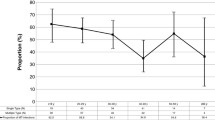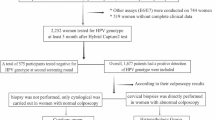Abstract
Purpose
HPV associated cervical transformation is characterized by well-defined steps, including persistent HPV infection and deregulated oncogene expression. Recent studies have suggested that a number of lower genital tract lesions are clonally related to cervical lesions. In the current study, HPV infections and oncogene expression were assessed in a large series of patients with multicentric lower genital tract disease to analyze the transformation steps in extracervical disease.
Methods
One hundred and thirty biopsies of 52 women treated for multicentric synchronous or metachronous lower genital tract intraepithelial neoplasias were collected. Up to seven multicentric specimens taken from one patient were studied with a maximum follow up of 20 years. HPV typing and p16ink4a immunostaining was performed.
Results
HPV DNA was present in 121 of 130 specimens (93%). HPV16 was frequently found in VIN, VaIN and AIN (73, 60 and 77%, respectively), whereas only 37% of CIN were HPV16 positive. Infections with identical HPV types in multicentric lesions were diagnosed in 46% of the HPV positive patients. p16INK4a expression was negative in the nine HPV negative lesions whereas about 90% of the high grade lesions showed diffuse p16 staining.
Conclusion
Our findings indicate that multicentric lower genital tract disease evolves through different pathways. Some cases were related to a high susceptibility towards HPV infections, while others exhibited features of clonal propagation of transformed cervical cell clones. The clinical management of the latter group is particularly challenging, because malignant cell clones can persist over a long time course.




Similar content being viewed by others
Abbreviations
- HPV:
-
Human papillomavirus
- PCR:
-
Polymerase chain reaction
- HR:
-
High risk
- VIN:
-
Vulvar intraepithelial neoplasia
- VaIN:
-
Vaginal intraepithelial neoplasia
- CIN:
-
Cervical intraepithelial neoplasia
- AIN:
-
Anal intraepithelial neoplasia
- DNA:
-
Desoxy-ribonucleic acid
- LEEP:
-
Loop electrosurgical excision procedure
- n.a.:
-
Not available
References
Andersen WA, Franquemont DW, Williams J, Taylor PT, Crum CP (1991) Vulvar squamous cell carcinoma and papillomaviruses: two separate entities? Am J Obstet Gynecol 165:329–335; discussion 335–336
Bollmann R, Mehes G, Torka R, Speich N, Schmitt C, Bollmann M (2003) Human papillomavirus typing and DNA ploidy determination of squamous intraepithelial lesions in liquid-based cytologic samples. Cancer 99:57–62
Castle PE, Solomon D, Schiffman M, Wheeler CM (2005) Human papillomavirus type 16 infections and 2-year absolute risk of cervical precancer in women with equivocal or mild cytologic abnormalities. J Natl Cancer Inst 97:1066–1071
Chiasson MA, Ellerbrock TV, Bush TJ, Sun XW, Wright TC, Jr. (1997) Increased prevalence of vulvovaginal condyloma and vulvar intraepithelial neoplasia in women infected with the human immunodeficiency virus. Obstet Gynecol 89:690–694
Dodge JA, Eltabbakh GH, Mount SL, Walker RP, Morgan A (2001) Clinical features and risk of recurrence among patients with vaginal intraepithelial neoplasia. Gynecol Oncol 83:363–369
Feoli-Fonseca JC, Oligny LL, Filion M, Brochu P, Simard P, Russo PA, Yotov WV (1998) A two-tier polymerase chain reaction direct sequencing method for detecting and typing human papillomaviruses in pathological specimens. Diagn Mol Pathol 7:317–323
Fox H, Wells M (2003) Recent advances in the pathology of the vulva. Histopathology 42:209–216
Frisch M, Glimelius B, van den Brule AJ, Wohlfahrt J, Meijer CJ, Walboomers JM, Goldman S, Svensson C, Adami HO, Melbye M (1997) Sexually transmitted infection as a cause of anal cancer. N Engl J Med 337:1350–1358
Hording U, Daugaard S, Junge J, Lundvall F (1996) Human papillomaviruses and multifocal genital neoplasia. Int J Gynecol Pathol 15:230–234
Hording U, Junge J, Daugaard S, Lundvall F, Poulsen H, Bock JE (1994) Vulvar squamous cell carcinoma and papillomaviruses: indications for two different etiologies. Gynecol Oncol 52:241–246
Hording U, Junge J, Poulsen H, Lundvall F (1995) Vulvar intraepithelial neoplasia III: a viral disease of undetermined progressive potential. Gynecol Oncol 56:276–279
Iversen T, Tretli S (1998) Intraepithelial and invasive squamous cell neoplasia of the vulva: trends in incidence, recurrence, and survival rate in Norway. Obstet Gynecol 91:969–972
Jacobs MV, Snijders PJ, van den Brule AJ, Helmerhorst TJ, Meijer CJ, Walboomers JM (1997) A general primer GP5+/GP6(+)-mediated PCR-enzyme immunoassay method for rapid detection of 14 high-risk and 6 low-risk human papillomavirus genotypes in cervical scrapings. J Clin Microbiol 35:791–795
Judson PL, Habermann EB, Baxter NN, Durham SB, Virnig BA (2006) Trends in the incidence of invasive and in situ vulvar carcinoma. Obstet Gynecol 107:1018–1022
Kaufman RH (1995) Intraepithelial neoplasia of the vulva. Gynecol Oncol 56:8–21
Klaes R, Friedrich T, Spitkovsky D, Ridder R, Rudy W, Petry U, Dallenbach-Hellweg G, Schmidt D, von Knebel Doeberitz M (2001) Overexpression of p16(INK4A) as a specific marker for dysplastic and neoplastic epithelial cells of the cervix uteri. Int J Cancer 92:276–284
Koutsky LA, Holmes KK, Critchlow CW, Stevens CE, Paavonen J, Beckmann AM, DeRouen TA, Galloway DA, Vernon D, Kiviat NB (1992) A cohort study of the risk of cervical intraepithelial neoplasia grade 2 or 3 in relation to papillomavirus infection. N Engl J Med 327:1272–1278
Negri G, Vittadello F, Romano F, Kasa A, Rivasi F, Girlando S, Mian C, Egarter-Vigl E (2004) p16ink4a expression and progression risk of low-grade intraepithelial neoplasia of the cervix uteri. Virchows Arch. 445:616–620
Nobbenhuis M, Walboomers J, Helmerhorst T, Rozendaal L, Remmink A, Risse E, van der Linden H, Voorhorst F, Kenemans P, CJLM M (1999) Relation of human papillomavirus status to cervical lesions and consequences for cervical-cancer screening: a prospective study. Lancet 354:20–25
Ostor AG (1993) Natural history of cervical intraepithelial neoplasia: a critical review. Int J Gynecol Pathol 12:186–192
Park JS, Jones RW, McLean MR, Currie JL, Woodruff JD, Shah KV, Kurman RJ (1991) Possible etiologic heterogeneity of vulvar intraepithelial neoplasia. A correlation of pathologic characteristics with human papillomavirus detection by in situ hybridization and polymerase chain reaction. Cancer 67:1599–1607
Petry KU (1996) HIV infection and neoplasia. Lancet 348:1317; author reply 1318
Petry KU, Kochel H, Bode U, Schedel I, Niesert S, Glaubitz M, Maschek H, Kuhnle H (1996) Human papillomavirus is associated with the frequent detection of warty and basaloid high-grade neoplasia of the vulva and cervical neoplasia among immunocompromised women. Gynecol Oncol 60:30–34
Ruhul Quddus M, Xu C, Steinhoff MM, Zhang C, Lawrence WD, Sung CJ (2005) Simplex (differentiated) type VIN: absence of p16INK4 supports its weak association with HPV and its probable precursor role in non-HPV related vulvar squamous cancers. Histopathology 46:718–720
Sano T, Oyama T, Kashiwabara K, Fukuda T, Nakajima T (1998) Expression status of p16 protein is associated with human papillomavirus oncogenic potential in cervical and genital lesions. Am J Pathol 153:1741–1748
Schiffman M, Herrero R, Desalle R, Hildesheim A, Wacholder S, Rodriguez AC, Bratti MC, Sherman ME, Morales J, Guillen D, Alfaro M, Hutchinson M, Wright TC, Solomon D, Chen Z, Schussler J, Castle PE, Burk RD (2005) The carcinogenicity of human papillomavirus types reflects viral evolution. Virology 337:76–84
Spitzer M (1999) Lower genital tract intraepithelial neoplasia in HIV-infected women: guidelines for evaluation and management. Obstet Gynecol Surv 54:131–137
Spitzer M, Krumholz BA, Seltzer VL (1989) The multicentric nature of disease related to human papillomavirus infection of the female lower genital tract. Obstet Gynecol 73:303–307
Taussig F (1940) Cancer of the vulva: An analysis of 155 cases. Am J Obstet Gynecol 40:764–779
Trimble CL, Hildesheim A, Brinton LA, Shah KV, Kurman RJ (1996) Heterogeneous etiology of squamous carcinoma of the vulva. Obstet Gynecol 87:59–64
van Beurden M, ten Kate FW, Tjong AHSP, de Craen AJ, van der Vange N, Lammes FB, ter Schegget J (1998) Human papillomavirus DNA in multicentric vulvar intraepithelial neoplasia. Int J Gynecol Pathol 17:12–16
van den Brule AJ, Meijer CJ, Bakels V, Kenemans P, Walboomers JM (1990) Rapid detection of human papillomavirus in cervical scrapes by combined general primer-mediated and type-specific polymerase chain reaction. J Clin Microbiol 28:2739–2743
van der Avoort IA, Shirango H, Hoevenaars BM, Grefte JM, de Hullu JA, de Wilde PC, Bulten J, Melchers WJ, Massuger LF (2006) Vulvar Squamous Cell Carcinoma is a Multifactorial Disease Following Two Separate and Independent Pathways. Int J Gynecol Pathol 25:22–29
Vinokurova S, Wentzensen N, Einenkel J, Klaes R, Ziegert C, Melsheimer P, Sartor H, Horn LC, Hockel M, von Knebel Doeberitz M (2005) Clonal history of papillomavirus-induced dysplasia in the female lower genital tract. J Natl Cancer Inst 97:1816–1821
von Knebel Doeberitz M (2002) New markers for cervical dysplasia to visualise the genomic chaos created by aberrant oncogenic papillomavirus infections. Eur J Cancer 38:2229–2242
Walboomers JMM, Jacobs MV, Manos MM, Bosch FX, Kummer JA, Shah KV, Snijders PJF, Peto J, Meijer CJLM, Munoz N (1999) Human papillomavirus is a necessary cause of invasive cervical cancer worldwide. J Pathol 189:12–19
Wang JL, Zheng BY, Li XD, Angstrom T, Lindstrom MS, Wallin KL (2004a) Predictive significance of the alterations of p16INK4A, p14ARF, p53, and proliferating cell nuclear antigen expression in the progression of cervical cancer. Clin Cancer Res 10:2407–2414
Wang SS, Trunk M, Schiffman M, Herrero R, Sherman ME, Burk RD, Hildesheim A, Bratti MC, Wright T, Rodriguez AC, Chen S, Reichert A, von Knebel Doeberitz C, Ridder R, von Knebel Doeberitz M (2004b) Validation of p16INK4a as a marker of oncogenic human papillomavirus infection in cervical biopsies from a population-based cohort in Costa Rica. Cancer Epidemiol Biomarkers Prev 13:1355–1360
Williams AB, Darragh TM, Vranizan K, Ochia C, Moss AR, Palefsky JM (1994) Anal and cervical human papillomavirus infection and risk of anal and cervical epithelial abnormalities in human immunodeficiency virus-infected women. Obstet Gynecol 83:205–211
Yang B, Hart WR (2000) Vulvar intraepithelial neoplasia of the simplex (differentiated) type: a clinicopathologic study including analysis of HPV and p53 expression. Am J Surg Pathol 24:429–441
zur Hausen H (1991) Human papillomaviruses in the pathogenesis of anogenital cancer. Virology 184:9–13
zur Hausen H (2002) Papillomaviruses and cancer: from basic studies to clinical application. Nat Rev Cancer 2:342–350
Author information
Authors and Affiliations
Corresponding author
Additional information
Monika Hampl and Nicolas Wentzensen contributed equally to the work.
Rights and permissions
About this article
Cite this article
Hampl, M., Wentzensen, N., Vinokurova, S. et al. Comprehensive analysis of 130 multicentric intraepithelial female lower genital tract lesions by HPV typing and p16 expression profile. J Cancer Res Clin Oncol 133, 235–245 (2007). https://doi.org/10.1007/s00432-006-0162-0
Received:
Accepted:
Published:
Issue Date:
DOI: https://doi.org/10.1007/s00432-006-0162-0




